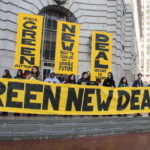Delving into How the City’s Office of Sustainability is Mapping Out a Cleaner, Greener Philadelphia Reality Check |
Reality Check | WURD radio Special to ecoWURD
The City of Philadelphia’s Office of Sustainability had its Outreach and Communications Coordinator Ciara Williams talk with Charles Ellison, host of WURD’s Reality Check, about the recent release of its annual Greenworks Review. The Review – a collection of perspectives and voices on the environment – is an extension of the City’s Greenworks Initiative which maps out a plan to enhance Philadelphians’ access to …
- Healthy, affordable, and sustainable food and drinking water.
- Healthy indoor and outdoor air.
- Clean, efficient, affordable energy.
- Preparation for climate change and reduce carbon pollution.
- Benefit from parks, trees, stormwater management, and healthy waterways.
- Safe, affordable, and low-carbon transportation.
- Cleaner neighborhoods.
- Sustainable education, employment, and business opportunities.
“This is Philadelphia’s long term plan towards reaching sustainability,” said Williams. “Sustainability is defined by these eight progress areas – from healthy food and drinking water to opportunities in the sustainability space. People should be engaged and active participants in this process.”
“One interesting thing about this idea of sustainability is that it’s broad. So, people who don’t necessarily call themselves environmentalists or directly involved in sustainable efforts are still contributing because we view sustainability as broad. When it comes to engage Philadelphians on this concept, we first look at what individual Philadelphians are doing and then see how that can fit into our sustainability efforts.”
Williams also discusses coordination with other city agencies, such as the Public Health Department, and between various agencies, particularly on climate change preparation and response (such as flooding and extreme heat).
“We talk about this idea of heat inequity,” In Philadelphia, not every neighborhood experiences heat the same way – in fact, some neighborhoods are 20 degrees hotter than others. It’s not randomized at all – we see the intersection between heat and economic vulnerability. We see neighborhoods that are mostly low income and mostly people of color.”



